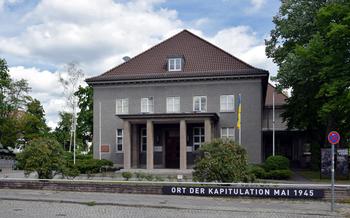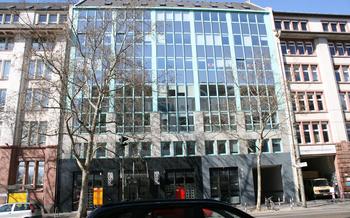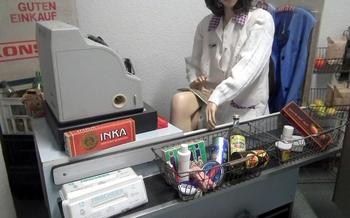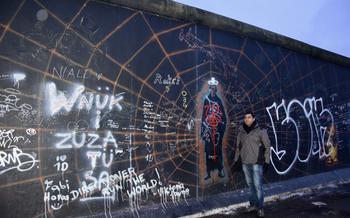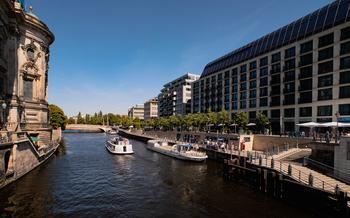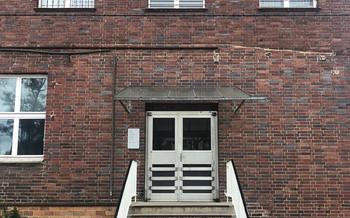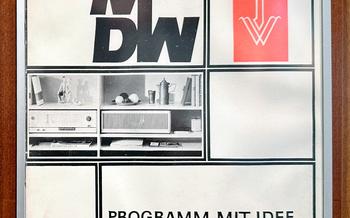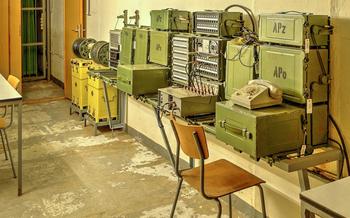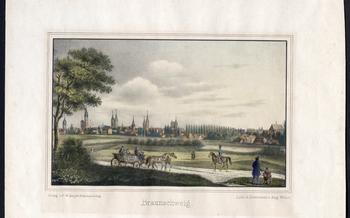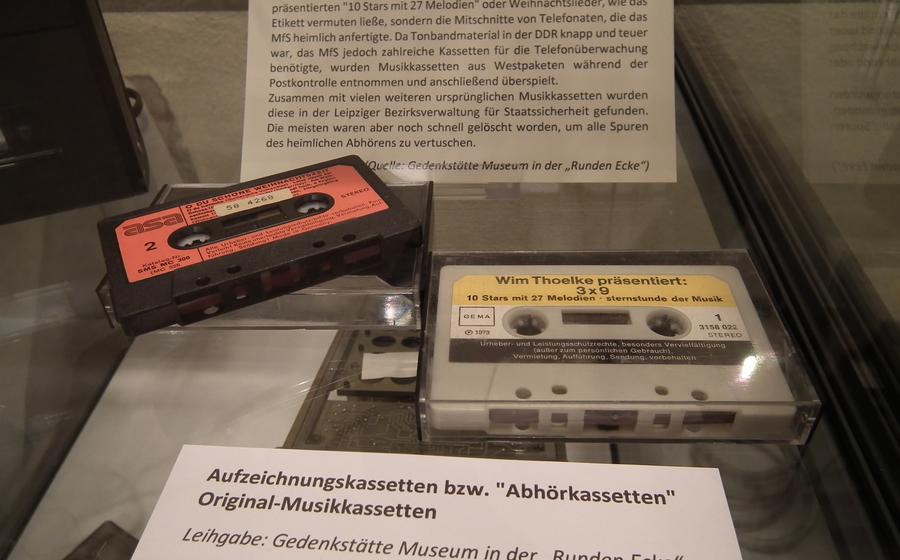
Museum in der Runden Ecke (Museum in the Round Corner)
- Museum in der Runden Ecke (Museum in the Round Corner)
- Location and Accessibility
- Hours of Operation and Admission
- Guided Tours: Unveiling the Secrets of the Stasi
- Exhibitions and Displays
- Interactive Elements
- Historical Documents and Artifacts
- Educational Programs
- Research and Documentation Center
- Events and Commemorations
- Educational Resources
- Memorial Garden: A Place of Remembrance
- Souvenir Shop
- Historical Context
- Insider Tip: Plan Your Visit Strategically
Museum in der Runden Ecke (Museum in the Round Corner)
The Museum in der Runden Ecke, or Museum in the Round Corner, holds a profound historical significance as the former headquarters of the Stasi (secret police) in Leipzig, East Germany. Its distinctive round corner design serves as a symbolic representation of the Stasi's omnipresence and pervasive surveillance during the communist regime. Through its comprehensive exhibitions and immersive displays, the museum offers visitors a unique opportunity to delve into the Stasi's methods of surveillance, political repression, and the peaceful revolution that unfolded in Leipzig, ultimately leading to the fall of the Berlin Wall and the reunification of Germany.
Location and Accessibility
The Museum in der Runden Ecke is conveniently located in the heart of Leipzig, at Dittrichring 24, 04109 Leipzig, Germany. Its central location makes it easily accessible by public transportation. Visitors can take tram lines 3, 7, 8, or 12, or bus lines 60 or 74, and get off at the "Runde Ecke" stop. For those arriving by car, limited street parking is available nearby. However, it is advisable to plan accordingly, as parking spaces can be scarce, especially during peak tourist seasons.
Hours of Operation and Admission
The Museum in der Runden Ecke is open to the public from Tuesday to Sunday, from 10 am to 6 pm. It remains closed on Mondays. To explore this fascinating museum, visitors can purchase tickets on-site or book them online in advance. Regular tickets are priced at €6, while students, seniors, and disabled individuals can avail discounted tickets at €Remember, advance booking is highly recommended, especially for larger groups, to avoid any inconvenience and secure a spot for your visit.
Guided Tours: Unveiling the Secrets of the Stasi
To fully grasp the significance and impact of the Stasi, guided tours offer an immersive and informative experience. Conducted in both German and English, these tours provide visitors with a deeper understanding of the Stasi's surveillance methods, political repression, and the peaceful revolution that brought about its downfall.
Led by knowledgeable guides, the tours delve into the museum's exhibits, shedding light on the Stasi's history, structure, and operations. Visitors are taken through the various rooms and sections of the former Stasi headquarters, gaining insights into the daily lives and working environment of the secret police.
Advance booking is highly recommended, especially for groups, to secure a spot on a guided tour. This ensures a more personalized experience and allows visitors to ask questions and engage in discussions with the guides.
Insider Tip: For a truly immersive experience, consider booking a guided tour in English. This allows visitors to fully understand the explanations and historical context provided by the guides, making the visit even more impactful and memorable.
Exhibitions and Displays
The Museum in der Runden Ecke features a comprehensive permanent exhibition dedicated to the history, methods, and impact of the Stasi on East German society. Through a combination of artifacts, documents, interactive displays, and multimedia presentations, visitors gain a deeper understanding of the Stasi's surveillance and repression techniques, as well as the resistance and opposition that ultimately led to its downfall.
Temporary exhibitions explore specific aspects of the Stasi's activities or related historical events, offering visitors a fresh perspective on the complexities of this era. These exhibitions often feature personal stories, rare documents, and thought-provoking insights into the lives of those affected by the Stasi regime.
Whether exploring the permanent exhibition or delving into the temporary displays, visitors are encouraged to engage with the interactive elements that bring the past to life. Multimedia screens, audio guides, and hands-on exhibits allow visitors to immerse themselves in the Stasi's world, handling surveillance equipment, trying on uniforms, and experiencing the chilling atmosphere of a Stasi interrogation room.
These interactive elements not only provide a tangible connection to the past but also underscore the museum's commitment to fostering a deeper understanding of this dark chapter in German history.
Interactive Elements
The Museum in der Runden Ecke offers a range of interactive elements to enhance visitors' engagement and understanding of the Stasi's history and methods. Multimedia displays utilize interactive screens, audio guides, and multimedia presentations to create immersive experiences that bring the past to life. These displays provide in-depth information on various aspects of the Stasi's activities, including surveillance techniques, political repression, and the peaceful revolution in Leipzig. Visitors can also engage with hands-on exhibits, allowing them to handle Stasi equipment, try on uniforms, and gain a tangible connection to the past. These interactive elements not only educate but also create a deeper emotional connection to the museum's subject matter, fostering a more profound understanding of the Stasi's impact on East German society.
Historical Documents and Artifacts
The Museum in der Runden Ecke houses a treasure trove of historical documents and artifacts that provide a tangible connection to the Stasi's oppressive regime. Original Stasi files, surveillance reports, and personal documents offer a glimpse into the lives of those who were monitored, persecuted, and imprisoned by the secret police. These documents reveal the extent of the Stasi's surveillance and control over East German society, from mundane everyday activities to political dissent.
Authentic Stasi equipment, uniforms, and personal belongings further enhance the visitor's understanding of the Stasi's operations. Visitors can examine surveillance cameras, listening devices, and other tools used to spy on citizens. Uniforms and personal items, such as Stasi officers' badges and identity cards, provide a human dimension to the regime, reminding visitors of the individuals who carried out the Stasi's repressive policies.
These historical documents and artifacts serve as powerful reminders of the pervasive surveillance and oppression that characterized life in East Germany under the Stasi regime. They offer visitors a unique opportunity to gain a deeper understanding of the Stasi's methods and the impact they had on the lives of countless individuals.
Educational Programs
The Museum in der Runden Ecke extends its educational offerings beyond its exhibitions and guided tours through a range of workshops, seminars, and school programs. These initiatives aim to deepen the understanding of the Stasi's history and legacy among students, teachers, and the wider community.
Workshops and seminars are designed to provide participants with a more comprehensive exploration of specific aspects of the Stasi's activities and their impact on East German society. These interactive sessions, led by experts in the field, delve into topics such as surveillance techniques, resistance movements, and the role of the Stasi in maintaining the GDR's repressive regime.
School visits form an integral part of the museum's educational mission. Guided tours tailored specifically for school groups offer students a hands-on encounter with history, allowing them to engage with authentic Stasi artifacts, documents, and personal stories. These tours promote historical awareness, critical thinking, and a deeper understanding of the consequences of authoritarianism.
Through these educational programs, the Museum in der Runden Ecke fulfills its role as a center of learning and remembrance, ensuring that the memory of the Stasi's oppressive practices remains alive and continues to inform future generations.
Research and Documentation Center
The Museum in der Runden Ecke houses an extensive archive, serving as a valuable resource for researchers and scholars interested in delving deeper into the history and legacy of the Stasi. This archive contains a vast collection of Stasi documents, research materials, and historical sources, providing a comprehensive overview of the organization's activities and impact.
Researchers and scholars can access this archive upon request, enabling them to conduct in-depth studies and gain insights into the inner workings of the Stasi. The availability of primary sources, such as Stasi files, surveillance reports, and personal documents, facilitates a deeper understanding of the regime's methods and its impact on East German society.
The Research and Documentation Center at the Museum in der Runden Ecke plays a crucial role in preserving and disseminating knowledge about the Stasi era. Through its extensive collection and accessibility to researchers, the center contributes to the ongoing study and understanding of this significant period in German history.
Events and Commemorations
The Museum in der Runden Ecke serves as a platform for remembrance and reflection through a variety of events and commemorations. Regular events, lectures, and discussions are held to explore different aspects of the Stasi era and its significance in German history. These events often feature guest speakers, historians, former Stasi victims, and experts who share their knowledge and personal experiences.
Public readings are another important aspect of the museum's commemorative efforts. Authors, historians, and former Stasi victims are invited to share their personal stories and experiences through public readings. These readings provide a powerful and intimate glimpse into the lives of those who were directly affected by the Stasi regime.
Through these events and commemorations, the Museum in der Runden Ecke not only educates visitors about the Stasi era but also fosters a sense of remembrance and reconciliation. It provides a space for dialogue, reflection, and understanding, ensuring that the legacy of the Stasi and its victims is not forgotten.
Educational Resources
The Museum in der Runden Ecke takes its educational mission seriously, providing visitors with a wealth of resources to deepen their understanding of the Stasi era. The museum's publications offer a range of perspectives on the Stasi's history and impact, from scholarly analyses to personal accounts by former victims. These publications are available for purchase at the museum's souvenir shop and can also be found in libraries and bookstores.
In addition to its publications, the museum's website serves as a valuable resource for researchers and the general public alike. It features digital exhibitions, educational materials, and interactive features that allow visitors to explore the Stasi's history in a dynamic and engaging way. These online resources are particularly useful for those who are unable to visit the museum in person.
By providing a diverse range of educational resources, the Museum in der Runden Ecke ensures that the lessons of the Stasi era are not forgotten and that future generations can learn from the mistakes of the past.
Memorial Garden: A Place of Remembrance
In addition to the museum's indoor exhibitions, visitors can explore the adjacent Memorial Garden, a tranquil space dedicated to the victims of the Stasi regime. This serene garden serves as a place of reflection and remembrance, honoring those who suffered under the oppressive surveillance and political repression of the Stasi.
The memorial features a variety of symbolic elements, including a sculpture representing the struggle for freedom and democracy, as well as a Wall of Remembrance inscribed with the names of Stasi victims. Visitors are invited to stroll through the garden, taking a moment to pause and remember the countless individuals whose lives were affected by the Stasi's actions.
The Memorial Garden is a poignant reminder of the human cost of authoritarianism and serves as a powerful testament to the resilience and determination of those who fought for freedom and justice in East Germany. It is a must-visit for anyone interested in understanding the complexities of Germany's recent past and the enduring legacy of the Stasi regime.
Souvenir Shop
Within the museum building, visitors will find a well-stocked souvenir shop offering a diverse range of items related to the Stasi era, the museum itself, and German history. History enthusiasts can delve into books that provide in-depth accounts of the Stasi's activities and their impact on society. For a tangible reminder of their visit, visitors can purchase souvenirs such as replicas of Stasi uniforms, badges, or historical posters. The shop also offers a selection of postcards, magnets, and other memorabilia that serve as keepsakes of the museum's powerful and thought-provoking exhibitions. Whether seeking educational materials or unique souvenirs, the museum shop provides visitors with an opportunity to further explore and commemorate this significant chapter in German history.
Historical Context
Leipzig holds a significant place in the history of the peaceful revolution that led to the fall of the German Democratic Republic (GDR) in 198The city was a hub of resistance and dissent during the communist regime, and the Museum in der Runden Ecke serves as a reminder of this tumultuous period. Visitors to the museum can gain a deeper understanding of the events that unfolded in Leipzig and how they contributed to the collapse of the GDR, making the museum a particularly relevant and poignant site for those interested in German history and the struggle for freedom and democracy.
Insider Tip: Plan Your Visit Strategically
To make the most of your visit, consider planning your trip strategically. Avoid peak tourist seasons and weekends when the museum tends to be crowded. Instead, opt for a weekday visit during the off-season to enjoy a quieter and more immersive experience. This will allow you toじっくりと explore the exhibitions, interact with the interactive displays, and engage with the knowledgeable museum staff without feeling rushed. Additionally, advance booking for guided tours is highly recommended, especially for groups, to secure your spot and ensure a personalized experience with a knowledgeable guide.
